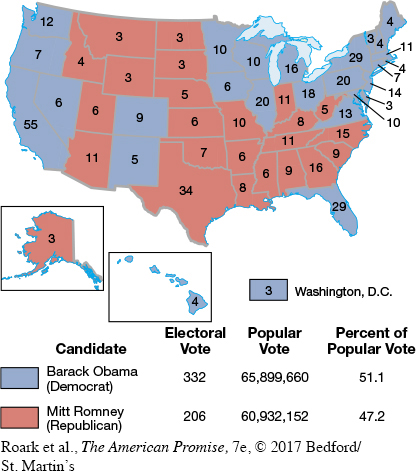The American Promise: Printed Page 914
The American Promise, Value Edition: Printed Page 829
The American Promise: A Concise History: Printed Page 946
Governing during Economic Crisis and Political Polarization
Obama won an election that represented momentous changes in American politics. The Republican nominee, Senator John McCain of Arizona, a Vietnam War hero, chose as his running mate Alaska governor Sarah Palin, the first Republican woman vice presidential candidate. In the Democratic Party, for the first time, an African American and a woman were the top two contenders. (See “Analyzing Historical Evidence: Caricaturing the Candidates: Clinton and Obama in 2008.”) In a hard-
Born to a white mother and a Kenyan father and raised in Hawai’i and Indonesia, Obama was the first African American to head the Harvard Law Review. He settled in Chicago, taught law, served in the Illinois Senate, and won election to the U.S. Senate in 2004. At the age of forty-
Defining “individual responsibility and mutual responsibility” as “the essence of the American promise,” Obama hoped to work across party lines to enact reforms in health care, education, the environment, and immigration policy, but he confronted a severe economic crisis. A recession had struck in late 2007, fueled by a breakdown in financial institutions that had accumulated trillions of dollars of bad debt, much of it from risky home mortgages. As the recession spread to other parts of the economy and the world, mortgage foreclosures skyrocketed, major companies went bankrupt, and unemployment rose to 9.8 percent in late 2010.
The American Promise: Printed Page 914
The American Promise, Value Edition: Printed Page 829
The American Promise: A Concise History: Printed Page 946
Page 915The Great Recession was so severe that Congress passed the Bush administration’s $700 billion Troubled Asset Relief Program in 2008 to inject credit into the economy and shore up banks and other businesses. Obama followed with the American Recovery and Reinvestment Act of 2009, $787 billion worth of spending and tax cuts to stimulate the economy and relieve unemployment. He also arranged a federal bailout of General Motors and Chrysler, saving some one million jobs related to the automobile industry. Finally, to address the sources of the financial crisis, Congress expanded governmental regulation with the Wall Street Reform and Consumer Protection Act in 2010. Nonetheless, the recovery was agonizingly slow, and income inequality reached its highest level since the 1920s.
With a Democrat-
Obama’s paramount achievement was passage of health care reform, putting the United States in step with the other advanced nations that subsidized some kind of health care for all citizens. The Patient Protection and Affordable Care Act of 2010 required that nearly everyone carry health insurance, and to that end, it provided subsidies and compelled larger businesses to cover their employees. The law also included protections for health care consumers and contained provisions to limit medical costs. Although liberals failed to get a public option to allow government-

“Obamacare” (a derisive label later embraced by its supporters), along with the government bailouts of big corporations, helped fuel a grassroots movement of mostly white, middle-

The intensely polarized political environment posed a roadblock to reducing unemployment and thwarted Obama’s efforts to reform environmental and immigration policy. Obama carried the burden of a nearly 8 percent unemployment rate into the 2012 election, where he faced Republican Mitt Romney. With the electorate deeply divided over the role of the federal government, Obama won easily in the electoral college, with 332 votes to Romney’s 206, and he captured 51 percent of the popular vote to Romney’s 47 percent (Map 31.4). Yet, following the 2014 midterm elections, Republicans took over both houses of Congress.
The American Promise: Printed Page 914
The American Promise, Value Edition: Printed Page 829
The American Promise: A Concise History: Printed Page 946
Page 917With Republicans in Congress blocking him at every turn, Obama used his executive authority to raise the minimum wage for federal workers, protect younger undocumented immigrants from deportation, and chip away at some of the racial injustices in the criminal justice system. He stiffened curbs on motor vehicle and power plant emissions, encouraged alternative energy development, and helped make possible a landmark climate change agreement signed in Paris in 2015 by 195 nations, which pledged action to reduce carbon emissions that threatened to devastate the earth.